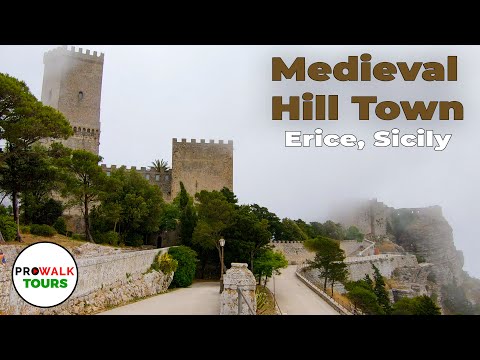Erice, Sicily Walking Tour - 4K - With Captions!

Welcome to Erice, Sicily! The Mother Church was built in 1314 by King Frederick of Aragon who took shelter in Erice during the uprising of the Sicilian Vespers between 1282 and 1314. The church was built for defensive purposes, because from the top pf bell tower it is possible to monitor the surrounding area. The church was restored in 1856 and the original interior mosaics and frescoes were lost.
The church is dedicated to Mary, Our Lady Assumed into Heaven. Mary is also the patron saint of the Erice, which holds their patron saint day on the last Wednesdays in August. Erice is located on top of Mount Erice, at about 2,460 ft (750 meters) above sea level and overlooks the town of Trapani. Unfortunately, it is too foggy to get a view of Trapani or the sea below. I started the morning in Palermo and drove over to San Vito where I filmed a short bike tour. The view of Erice at the intro to the video is from San Vito. The name of the town derives from Erix, a mythological character, son Aphrodite and Bute, killed by Hercules.
The town was founded in the 9th century BC by Trojans fleeing from the destruction of Troy. Prince Elimo together with Aceste and other companions took to the sea to find safety in Sicily and stopped here along the western coast of Sicily. Prince Elimo left Troy with 20 ships and 3000 men. When they landed here, they founded two towns, Segesta and Elima (Erice).
The entire western territory of Sicily became known as the Elimica region and the people were known as the Elimi. A town existed here prior to the arrival of the Trojans who united with the indigenous population. The town was disputed over for centuries by the Syracusans and the Carthaginians until the conquest by the Romans in 244 BC. The other town of Segesta is located more inland where there is still an ancient Greek temple built in the 5th century BC which is now a popular tourist attraction. The first people to settle here in Erice founded a sanctuary dedicated to Aphrodite (Venus for the Romans), where "sacred prostitution" was practiced. Erice became an important center for the Romans where they venerated Venus, the first goddess of Roman mythology.
The sanctuary was considered with equal importance by the Phoenicians, Carthaginians, Greeks and Romans. A cult was formed in honor of the goddess called the Venus Erycina, referring the city of Eryx (Erice). The cult was eventually transformed by the Romans, who rebuilt the Temple as Venus Erycina . The statue of the goddess from the temple of Erice was brought to Rome in 211 BC.
The importance of the Roman cult of Venus Erycina is evidenced by the discovery of republican coins dated 57 BC where the temple of Erice is depicted . Between the 12th and 13th centuries, the Normans built a castle on the site of the sanctuary, called the Castello di Venere, Castle of Venus. It was during this time of Norman Rule in 1077 AD that the name of the town was changed to Monte San Giuliano, a name that stuck until 1934. Starting around 80 BC, Erice lost its significance in the region and was at times abandoned.
During the time of Arab rule (831 - 1061), it is believed that the town was uninhabited. The town did not regain its population until the medieval times with the conquest of the Normans, who subsequently renamed the town. In ancient times, this mountain was thought to be second highest in Sicily with the first being Mt. Etna. Mount Erice, at only 2,185 ft (666 meters) has the appearance of being much higher than it actually is. Mt. Etna is almost 11,000 ft high (3,350 meters). There are a total of 60 churches in this small town! It is possible to purchase a ticket which provides access to several churches as well as the bell tower next to the Chiesa Madre we saw at the beginning of the tour.
It is common for Erice to be covered in clouds so coastal views are not always possible. Locally these clouds are called "kisses of Venus." Just around the corner is the Church of San Giuliano, built in 1070 AD. It is located at the highest point in the city. Apparently, everything in Erice is closed on Monday afternoons. We are now walking towards the castle and the beautiful and amazing Torretta Pepoli....which we won't see because of the fog.
The gardens, located around the Castle of Venus, were made by Agostino Pepoli in 1872 after he was granted a lease to the fortress and towers to return them to their former glory. The gardens were added to refine the location and everything was paid for by the patron of Trapani. The "Castle of Balio and Pepoli" are really just the defensive towers for the Castle of Venus. This leads to a lookout with beautiful views, but.... Below these defensive towers is the Torretta Pepoli (Pepoli Tower), a structure built by Agostino Pepoli between 1872 and 1880.
The tower was used by Agostino Pepoli to welcome literary friends of the time and as a place of study for his archaeological research. There it is!! For those who are in Trapani and who want to visit Erice, there is a cable car which will take you right to the parking lot where this walk began in just 10 minutes! If you are enjoying this video and would like to see more, please consider subscribing. If you are watching this on your TV, simply use the Youtube App on your smart phone to access the Prowalk Tours channel. From there you can click on the SUBSCRIBE button. Thank you! And if it's not too much to ask, please click the LIKE button as well. This really helps out my channel. Grazie! I recommend looking at Erice on Google Earth to get a better view of this castle. It is pretty impressive.
In the early Middle Ages most of the remains of the sanctuary were lost, and a small church dedicated to Santa Maria della Neve was built in the area, in conjunction with the construction of the castle by the Normans (late 11th-12th century). Only a small part of the sanctuary is all that remains of the ancient building, but some fine granite columns still exist in other parts of the city that were taken from the temple. The fortress was the "royal square" for the Aragonese viceroys until the 16th century. The castle was later converted into a prison by the Bourbons.
Artifacts that were found at this site during excavations can now be seen at museum in Trapani. The castle is built on the site where the supposed battle between Eryx and Hercules took place. Recently, Erice was used as the inspiration for scenes in the recent Warner Bros. movie, Aquaman which takes place in Sicily, although it was filmed in Australia. This road leads right back to the Porta Trapani where this tour began.
2021-06-20 02:19


